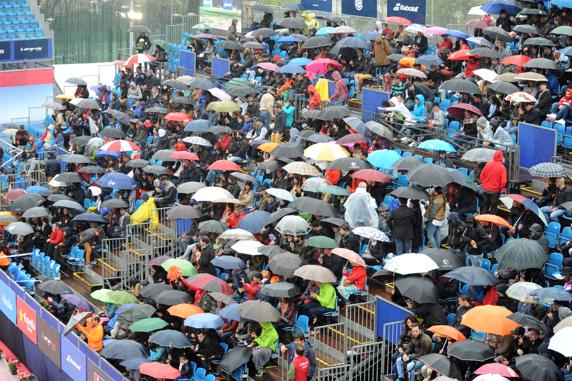In this series of articles I share with you tips that will help you win more matches and have more fun playing under “wet” conditions. In last week’s article, I gave you some tips on how to defend when the floor, ball or glass is wet. Today, we will study the defense even further.
Side wall, NO NO NO…!
If you are starting to play padel, or even if you are an intermediate padel player, you probably admire the elegance of Sanyo Gutierrez when he hits the ball after it bounces on the side wall. Today I must say, FORGET SANYO!
The conditions of play for the average padel player, including you, your friends, mine and my students, are very different than that of Sanyo when he plays World Padel Tour matches. We play under “dirty” conditions, which includes wind, sun on the face and rain! Sanyo plays, more often than not, under perfect conditions. So don’t imitate him by trying to hit the ball after it bounces on the side wall.
Forget the side wall. Avoid it. Hate it. It is perhaps your worst enemy. A ball that bounces on the sidewall will slide on it and travel fast into the back wall. Most likely you will not be able to hit it back in the direction of your opponent.
Thus, avoid at any cost that the ball bounces on the sidewall. Instead, stand a little closer to the side wall than usual and try to intercept any ball that goes in the direction of your side wall. Then hit it back in the direction of your opponents.
Are your knees working? Use them!
Stand lower than usual when defending. Lower your center of gravity. Most incoming “wet” balls will tend to bounce low. All the more if the ball reaches the back wall. If you are bending your knees, the process of returning balls will feel more natural because to a low ball you need to present a “low racket”.
Low back-swing
This is connected to the point I made before. As explained, balls will tend to bounce low and slide down after bouncing on the back wall. If your padel racket is low, starting right off the back-swing, it will be easier for you to return the ball in the direction of your opponent.
Lob, long follow through
If you ever took padel lessons, you probably know that one of the things that are crucial to play a good lob is to produce a long follow through. The length of the follow through determines the height and distance that the ball will travel. A ball that is wet, is a ball that is heavy. Surely heavier than a dry ball. Therefore, when hitting a wet ball, make sure that your follow through is longer than usual. This will make the ball fly higher and help you avoid those ugly short lobs.
Against the wall, do it with care
A wet ball is usually a heavy ball. Yes, with one exception: when you hit a “contra”. If you don’t know what a “contra” is, let’s just say that this is what we call a forehand that you play in the direction of your own back wall with the intention that the ball flies back to the other side of the court. If you have tried this with a wet ball, you probably felt like Terminator. Most likely the ball flew very very high into the sky. No, you are not Terminator. You are not stronger than usual. The reason why the ball tends to fly so high is that there is no grip between the ball and the glass. This forces the ball to fly more vertically than usual.
Therefore my recommendation is that when you play a “contra”, that you do it softer (yet firm) and more horizontally than usual.
Would you like to learn more? Then come back next week on Wednesday. I will give you some tips that will help you improve your service and return when playing under “wet” conditions.
[simple-author-box]














